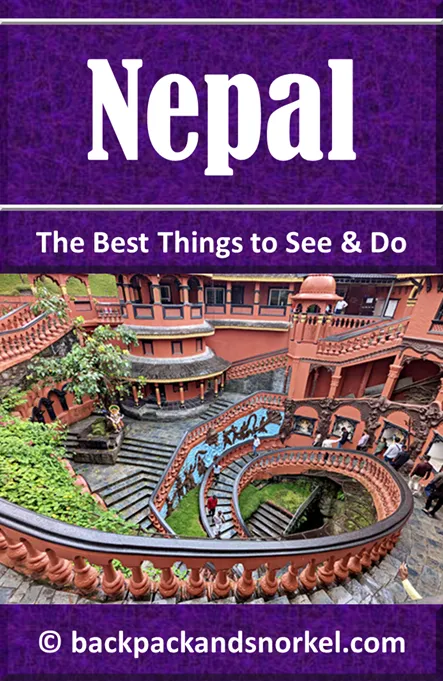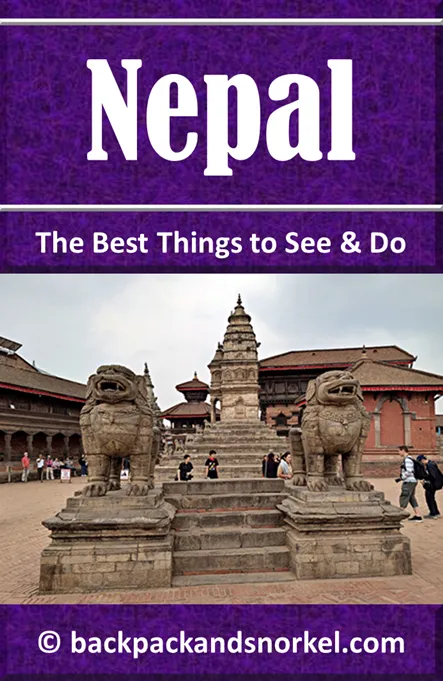Statues of Narsingha and Hanuman: Your Guide to Patan's Protectors - Nepal Purple Travel Guide
(map, reviews)
This is Premium Content! To access it, please download our
Backpack and Snorkel Purple Travel GuideThe statues of Narsingha and Hanuman stand side-by-side in Patan Durbar Square as powerful symbols of divine strength, protection, and devotion. These two revered Hindu figures, one a fierce avatar of Vishnu, the other the devoted servant of Rama, are placed in front of the Royal palace, underscoring their historic and religious importance.

Here at Backpack and Snorkel Travel Guides, we typically promote self-guided walking tours.
But we realize that not everybody likes to walk by themselves in a foreign city. So, just in case that you rather go with ab guide: NO PROBLEM! Please see the Viator tours below.
free GuruWalk tours
paid Viator tours
Importance of Narsingha: The Lion-Man Avatar
The Narsingha statue depicts the dramatic half-lion, half-man incarnation of Lord Vishnu. According to Hindu mythology, Narsingha appeared to defeat the demon Hiranyakashipu and restore cosmic order. This form of Vishnu symbolizes the destruction of evil and protection of dharma (righteousness). The statue shows Narsingha tearing open the demon with a fierce expression - a striking image of divine wrath and justice.
In Patan Durbar Square, the Narsingha statue stands as a reminder of the king's duty to uphold justice and protect his people. It also reflects the royal family's devotion to Vishnu during the Malla period, when much of the square's iconic architecture was built.
History of the Narsingha Statue
The Narasimha Statue in Patan Durbar Square, located at the entrance to Sundari Chowk, was installed on February 9, 1698, during the reign of King Bhupatindra Malla. An inscription on the pedestal of the statue credits Bhupatindra Malla and his uncle Ugra Malla with its establishment. The inscription also mentions that a ‘guthi’ (a local religious trust) was assigned the responsibility of washing the statue with ghee six times a year on specific dates.
Importance of Hanuman: The Devoted Guardian
Nearby, the Hanuman statue represents unwavering loyalty and physical strength. Hanuman, the monkey god and faithful follower of Lord Rama, is beloved in Nepal and India alike. Worshippers often approach this statue for blessings of courage, protection, and success, especially before starting a journey or facing a challenge.
The Hanuman statue in Patan Durbar Square often wears layers of red vermillion powder (sindoor or abir), applied by devotees as an offering.
Vermillion is offered as a gesture of reverence to the deity. Applying it is a symbolic way of acknowledging the presence and power of the divine. By applying vermillion, devotees believe they are awakening or energizing the image of the deity. In this context, it is not just a statue anymore. The vibrant red color of vermillion represents shakti - the divine feminine energy or life force. In Hindu belief, red is associated with strength, purity, and protection, which is why it's commonly used in temples and rituals.
Placement of the Hanuman Statue at palace entrances and temples reflects his traditional role as a guardian figure.
History of the Hanuman Statue
The Hanuman statue in Patan Durbar Square, located near the entrance to Sundari Chowk, was installed during the reign of King Bhupatindra Malla, who ruled from 1696 to 1722. While the exact year of installation is not known, it is generally attributed to the early 18th century, aligning with Bhupatindra Malla's active patronage of art and architecture during that period.
Ganesh, Narasimha, Hanuman and the concept of Siddhi
This statue is part of a trio of deities: Ganesh, Narasimha, and Hanuman.
Within the context of Hindu and Tantric traditions, there is a significant connection between the three deities and the concept of ‘Siddhi’, which translates to ‘perfection’, ‘accomplishment’, or ‘supernatural powers’.
Tantric practices aim to harness the powers of these deities to achieving or possessing extraordinary powers and accomplishments, both spiritual and material.
Therefore the placement of these three deities together could be seen as a location that is rich in spiritual power.
Ganesha and Siddhis:
Ganesha is widely regarded as the remover of obstacles and the god of beginnings. His association with Siddhis (supernatural powers) comes from his ability to help devotees remove physical, spiritual, and mental obstacles on the path to success, which can be seen as a form of Siddhi. Additionally, Ganesha is often associated with Siddhi and Buddhi (intellect) as his consorts, symbolizing the completion of both material and intellectual accomplishments.
Hanuman and Siddhis:
Hanuman is famously known for his immense strength, speed, and devotion, all of which are considered forms of Siddhi. His devotion to Lord Rama is often linked to his acquisition of these powers, and many of his actions in the Ramayana (such as flying across the ocean or carrying a mountain) reflect his Siddhis. The Hanuman Statue, praises his powers, emphasizing his supernatural abilities.
Narasimha and Siddhis:
Narasimha, the half-man, half-lion avatar of Vishnu, is associated with overcoming insurmountable obstacles (such as defeating the demon king Hiranyakashipu). While Narasimha is not typically depicted as a deity who directly grants Siddhis, his power and protection are symbolic of the divine strength that overcomes evil and restores order, which can be seen as a form of cosmic Siddhi in a more metaphorical sense.
Back to your self-guided tour
Author: Rudy at Backpack and Snorkel
Bio: Owner of Backpack and Snorkel Travel Guides. We create in-depth guides to help you plan unforgettable vacations around the world.
Other popular Purple Travel Guides you may be interested in:
Like this Backpack and Snorkel Purple Travel Guide? Pin these for later:





